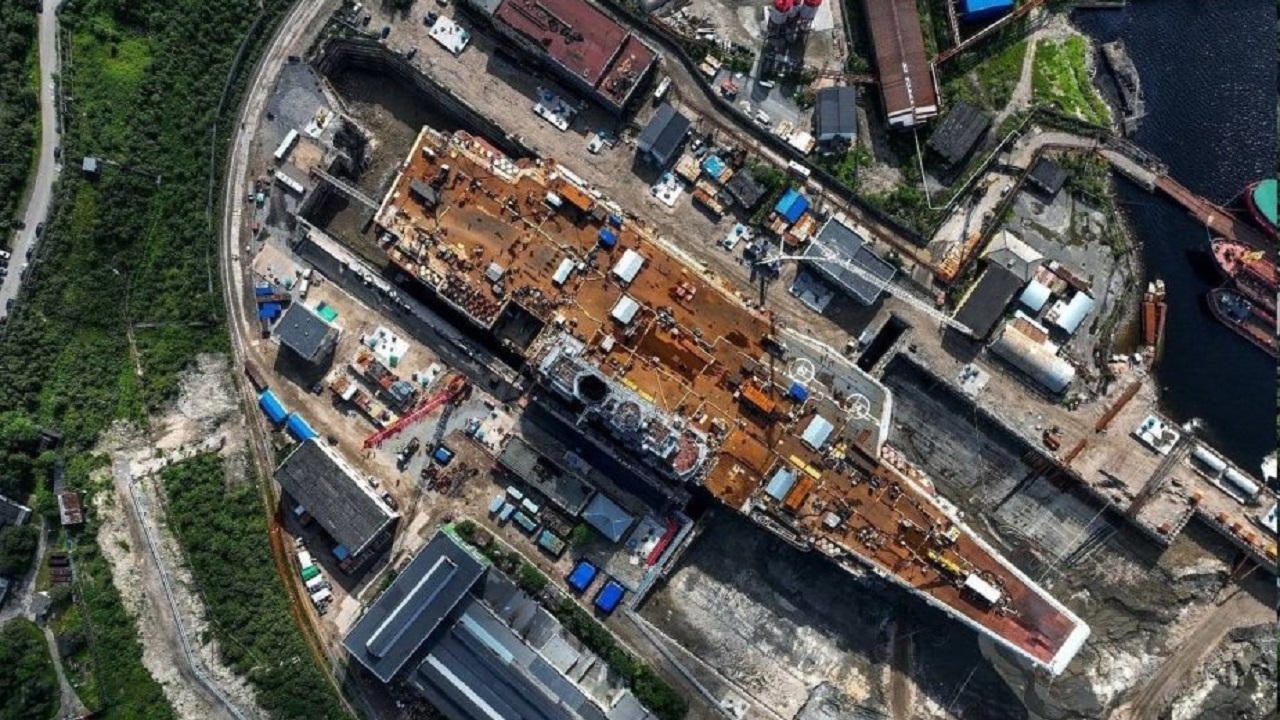The latest photo of the stricken, hard luck Russian carrier Admiral Kuznetsov was released by a Telegram Channel called “Military Informant” as annotated by the online site Navy Recognition on August 8. It doesn’t look good. The aerial image has the lone carrier laid up in dry dock and the entire deck is a rust-colored brown. The flight deck appears to be under massive construction and only one small section is intact. Numerous shacks for workers are on the deck. It has been reported that the carrier won’t be ready until 2024. But by the looks of the photo, this ship may need construction past that date. There is no way this cursed beast is going anywhere soon.
Well, So Much for the Russian Carrier Program
I have written before that Russia may not even need an aircraft carrier. The existing Russian nuclear triad is sufficient and there are newer ICBMs and ballistic missile submarines. Moscow is fighting a land war in Ukraine and the navy has been sidelined since the sinking of the flagship guided missile cruiser Moskva in April.
No Prestige To Be Seen Here
But one would think that Russia would have an urgent plan of action for the Kuznetsov. It has been in re-fit mode since 2017. Carriers allow a country to have military prestige and the ability to project power beyond its neighborhood. The Kuznetsov did have a combat deployment in Syria in 2016, but it carried only 15 airplanes and two were lost because of accidents. The battle group even had a tug-boat as an escort ship unless the Russian carrier broke down again and needed a tow back to Russia.
The Forgotten and Neglected Navy
Now Vladimir Putin is focused on Ukraine and his military industrial complex is under various sanctions. The current need is for workers to build more precision-guided missiles, tanks, and armored vehicles to stop the bleeding after Ukraine’s successful counter-offensive. The Russian navy has been an afterthought – except for Russian submarines that may be on the move and ready for a potential nuclear strike should Armageddon occur.
Kuznetsov Gets an ‘F’ Grade
The Kuznetsov joined the Russian navy in 1995. It was not designed to be a “Blue Water” carrier that could deploy to another hemisphere. The Russian navy wanted it to protect the homeland against enemy submarines and surface ships that would sneak close to shore and fire ballistic or cruise missiles at Russia. It wasn’t able to stay out for long deployments at sea – the maximum it could steam was around two to three months before it ran out of fuel while belching black smoke from the dirty mazut it burned. This ugly fuel is a far cry from nuclear power and so the Kuznetsov is woefully out of date.
Bad Luck In Dry Dock
One of the reasons the original retrofit of the carrier has lasted so long is that in 2018, a crane fell and tore a 200 square foot hole on the deck. This likely explains why the Russian shipbuilders have been forced to scrap the entire deck and have started all over. Plus, a fire in 2019 killed two people and injured 14, setting the timeline back even more.
What’s the Problem with the Navy?
The mystery is why the Russian navy doesn’t have more urgency to get the Kuznetsov ready for sea. Putin loves prestige projects and having a carrier would show the world the Russian navy is back to its Cold War self. I was surprised at how poorly the Russian army has conducted itself in Ukraine. Maybe the navy is over-rated as well. The Black Sea fleet has been rendered mostly useless. An amphibious landing in Odessa never materialized. The navy simply has not played up to its potential. The Kuznetsov is a reminder that Russian naval power is waning and that makes Putin rely more on his submarine portion of the nuclear triad, which could convince him that the nuclear option is always close at hand.
Expert Biography: Serving as 1945’s Defense and National Security Editor, Dr. Brent M. Eastwood is the author of Humans, Machines, and Data: Future Trends in Warfare. He is an Emerging Threats expert and former U.S. Army Infantry officer. You can follow him on Twitter @BMEastwood. He holds a Ph.D. in Political Science and Foreign Policy/ International Relations.

